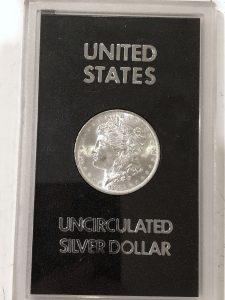 REMINDER: If you are not a member of the ANA, I will pay your 2021 Gold Membership dues for the first 25 readers of the Coin Collectors Blog who join during National Coin Week. All you have to do is click this link and use the Promotion Code NCW21SB when you check out.
REMINDER: If you are not a member of the ANA, I will pay your 2021 Gold Membership dues for the first 25 readers of the Coin Collectors Blog who join during National Coin Week. All you have to do is click this link and use the Promotion Code NCW21SB when you check out.
GSA Sale #3 stepped up its advertising (Image from u/GucciMamba666 on Reddit)
By 1964, the price of silver skyrocketed, making U.S. coins worth less than the metals used to make them. The economics led to a fiscal crisis that had the government rethinking the monetary system.
Silver coins were no longer required to back the U.S. dollar. Along with a law passed by Congress that ordered the General Services Administration to consolidate the government’s real estate usage came the discovery of the largest hoard in history.
Before the GSA started to clean out government-owned buildings, the government knew that they had stored silver coins in a few places. They did not know how many there were and the number of places they were stored.
Congress passed laws that caused over-production and hoarding. The Coinage Act of 1873, also called “The Crime of ’73,” caused a withdrawal of silver from the market. The Bland-Allison Act overturned it in 1878 that required the Treasury to purchase silver from U.S. mines to strike dollars for circulation. Since most silver mining was in Nevada, the Carson City Mint was striking more coins than needed.
The Sherman Silver Purchase Act became law in 1890. It raised the monthly amount of silver the Treasury purchased to 4.5 million ounces per month. The goal was to boost the economy to stem inflation. The law caused more dollars produced in Carson City with no place to distributed them.
To help Great Britain fund their war efforts, the Pittman Act authorized the melting of 350 million silver dollars to be sold at $1.00 per ounce. By the end of the war, over 270 million coins were melted for bullion. It was not enough to deplete the storage. The Act required the Mint to strike new coins with the silver repaid by Britain by 1933.
After several years of cleaning out vaults in different government-owned buildings, the GSA found 2,825,219 Morgan Dollars with the CC mintmark. They also found 112,145 coins from other branch mints. Within those additional coins, the GSA found 84,165 circulated Seated Liberty, Morgan, and Peace Dollars.
The government did not know what to do with the coins. Since they were in Treasury’s vaults, it was up to the Treasury to decide what to do with them. The Treasury’s role changed with the passage of the Federal Reserve Bank Act of 1913 and said that the best they could do was melt the coins. The U.S. Mint did not want the coins back since their job is to produce the coins. The Federal Reserve claimed it had no jurisdiction over the coins since the production and storage occurred before the formation of the Fed.
The GSA was the only agency that had experience liquidating government surplus. But these coins were not ordinary. Many collectors predicted that the sale of these coins would significantly change the numismatic market.
After the sale was over, the once rare 1882-1884 Carson City Dollars became more available. For example, the GSA found 962,638 of the 1,360,000 minted 1884-CC dollars in storage. It changed the rarity of the coins and the prices of previous purchases plunged.To sell these coins, the GSA created a special hardpack to hold the circulated coins. The hard-pack would be placed into a box with a certificate of authenticity, and the coins were made available through a mail-bid auction sale.
Coins struck in Carson City would be housed in a plastic case called a lens that said “Carson City” across the top. Other uncirculated coins were placed in a generic case. These coins are called GSA Morgans or GSA Non-CC Morgans.
For circulated coins, the GSA created the Soft Pack. The coins were sealed in mylar with a plastic token and placed in a blue envelope. Collectors refer to these coins as GSA Blue Packs. The GSA did not keep records of the number of Blue Packs sold. However, some have estimated that the GSA created about 100,000 Blue Packs.
- GSA Bluepack Envelope
- 1922 Peace Dollar in GSA Bluepack package
- GSA Bluepack COA
- GSA Information about the sale of the coins
From 1972 through 1980, the GSA held a series of eight sales. Most were mail-bid type auctions. The last two in 1980 were call-in bidding sales.
My father was cleaning his house, preparing to move into a condo before the pandemic shutdowns and found his GSA Morgan Dollars. He mailed the coins to me for my collection. Three are Carson City dollars, and one struck in New Orleans. My father purchased the coins during the first two GSA sales. He said that he tried to purchase more during the 1980 sales but was outbid.
I will eventually send the coins to NGC to have them graded in their original holder. For now, I found an online seller with four empty GSA boxes. Since I have the original Certificates of Authenticity, I will have complete packages.







